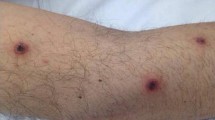Abstract
Members of the Fusarium solani species complex (FSSC) are causing the majority of the fusariosis in humans. Disseminated fusariosis has a high mortality and is predominantly observed in patients with leukemia. Here, we present the case of a fatal infection by a Fusarium strain with a degenerated phenotype, in a patient with acute lymphatic leukemia. Multiple nasal and skin biopsies as well as blood cultures yielded fungal growth, while in direct and histopathological examination of biopsy material septate hyphae were visible. Initial colonies were white with slimy masses with microconidia reminiscent of Fusarium/Acremonium, but with conidiospore production directly on the hyphae. Multi-locus sequence typing discerned a pionnotal—morphologically degenerated—colony of the recently recognized F. petroliphilum as etiological agent. The culture returned to a typical F. solani species complex morphology only after several weeks of growth in culture. Antifungal susceptibility tests indicate amphotericin B as best drug for this FSSC member rather than any of the azoles or echinocandins.


Similar content being viewed by others
References
Nucci M, Anaissie E. Fusarium infections in immunocompromised patients. Clin Microbiol Rev. 2007;20:695–704.
de Hoog GS, Guarro J, Gené J, Figueras MJ. Atlas of clinical fungi. 3rd ed. Utrecht: CBS-KNAW Fungal Biodiversity Centre, CD-ROM; 2011.
Horn DL, Freifeld AG, Schuster MG, Azie NE, Franks B, Kauffman CA. Treatment and outcomes of invasive fusariosis: review of 65 cases from the PATH Alliance®registry. Mycoses 2014. doi:10.1111/myc.12212. [Epub ahead of print].
O’Donnell K, Sutton DA, Fothergill A, et al. Molecular phylogenetic diversity, multilocus haplotype nomenclature, and in vitro antifungal resistance within the Fusarium solani species complex. J Clin Microbiol. 2008;46:2477–90.
Zhang N, O’Donnell K, Sutton DA, et al. Members of the Fusarium solani species complex that cause infections in both humans and plants are common in the environment. J Clin Microbiol. 2006;44:2186–90.
O’Donnell K, Sutton DA, Rinaldi MG, et al. Internet-accessible DNA sequence database for identifying Fusaria from human and animal infections. J Clin Microbiol. 2010;48:3708–18.
Debourgogne A, Gueidan C, de Hoog S, Lozniewski A, Machouart M. Comparison of two DNA sequence-based typing schemes for the Fusarium solani species complex and proposal of a new consensus method. J Microbiol Methods. 2012;91:65–72.
Short DP, O’Donnell K, Thrane U, et al. Phylogenetic relationships among members of the Fusarium solani species complex in human infections and the descriptions of F. keratoplasticum sp. nov. and F. petroliphilum stat. nov. Fungal Genet Biol. 2013;53:59–70.
Summerbell RC, Schroers HJ. Analysis of phylogenetic relationship of Cylindrocarpon lichenicola and Acremonium falciforme to the Fusarium solani species complex and a review of similarities in the spectrum of opportunistic infections caused by these fungi. J Clin Microbiol. 2002;40:2866–75.
Tortorano AM, Richardson M, Roilides E, et al. ESCMID & ECMM joint guidelines on diagnosis and management of hyalohyphomycosis: Fusarium spp, Scedosporium spp, and others. Clin Microbiol Infect. 2014;20 Suppl s3:27–46.
Guarro J. Fusariosis, a complex infection caused by a high diversity of fungal species refractory to treatment. Eur J Clin Microbiol Infect Dis. 2013;32:1491–500.
Azor M, Gené J, Cano J, Guarro J. Universal in vitro antifungal resistance of genetic clades of the Fusarium solani species complex. Antimicrob Agents Chemother. 2007;51:1500–3.
Alastruey-Izquierdo A, Cuenca-Estrella M, Monzón A, et al. Antifungal susceptibility profile of clinical Fusarium spp. isolates identified by molecular methods. J Antimicrob Chemother. 2008;61:805–9.
Kebabcı N, van Diepeningen AD, Ener B, et al. Fatal breakthrough infection with Fusarium andiyazi: new multi-resistant aetiological agent cross-reacting with Aspergillus galactomannan enzyme immunoassay. Mycoses. 2013;57:249–55.
Möller EM, Bahnweg G, Sandermann H, Geiger HH. A simple and efficient protocol for isolation of high molecular weight DNA from filamentous fungi, fruit bodies, and infected plant tissues. Nucl Acids Res. 1992;20:6115–6.
Davari M, Wei SH, Babay-Ahari et al. Geographic differences in trichothecene chemotypes of Fusarium graminearum in the Northwest and North of Iran. World Mycotoxin J. 2013;6:137–50.
Clinical and Laboratory Standards Institute. Reference method for broth dilution antifungal susceptibility testing of filamentous fungi. Approved standard. 2nd ed. Document M38-A2. Wayne, PA: Clinical and Laboratory Standards Institute; 2008.
Jossi M, Ambrosioni J, Macedo-Vinas M, Garbino J. Invasive fusariosis with prolonged fungemia in a patient with acute lymphobastic leukemia: case report and review of the literature. Int J Infect Dis. 2010;14:e354–6.
Nucci M, Anaissie EJ, Queinoz-Telles F, et al. Outcome predictors of 84 patients with hematologic malignancies and Fusarium infection. Cancer. 2003;98:315–9.
Grigis A, Farina C, Symoens F, Nolard N, Goglio A. Nosocomial pseudo-outbreak of Fusarium verticillioides associated with sterile plastic containers. Infect Control Hosp Epidemiol. 2000;21:50–2.
Hsiue HC, Ruan SY, Kuo YL, Huang YT, Hsueh PR. Invasive infections caused by non-Aspergillus moulds identified by sequencing analysis at a tertiary care hospital in Taiwan, 2000–2008. Clin Microbiol Infect. 2010;16:1204–6.
Azor M, Gené J, Cano J, Guarro J. Universal in vitro antifungal resistance of genetic clades of the Fusarium solani species complex. Antimicrob Agents Chemother. 2007;51:1500–3.
Nedret Koç A, Erdem F, Patıroĝlu T. Case report. Acremonium falciforme fungemia in a patient with acute leukaemia. Mycoses. 2002;45:202–3.
James EA, Orchard K, McWhinney PH, et al. Disseminated infection due to Cylindrocarpon lichenicola in a patient with acute myeloid leukaemia. J Infect. 1997;34:65–7.
Rodriguez-Villalobos H, Georgala A, Beguin H, et al. Disseminated infection due to Cylindrocarpon (Fusarium) lichenicola in a neutropenic patient with acute leukaemia: report of a case and review of the literature. Eur J Clin Microbiol Infect Dis. 2003;22:62–5.
Conflict of interest
J.F.M. received grants form Astellas, Merck and Basilea. He has been a consultant to Basilea and Merck and received speaker fees from Merck and Gilead.
Author information
Authors and Affiliations
Corresponding author
Rights and permissions
About this article
Cite this article
Ersal, T., Al-Hatmi, A.S.M., Dalyan Cilo, B. et al. Fatal Disseminated Infection with Fusarium petroliphilum . Mycopathologia 179, 119–124 (2015). https://doi.org/10.1007/s11046-014-9813-x
Received:
Accepted:
Published:
Issue Date:
DOI: https://doi.org/10.1007/s11046-014-9813-x




